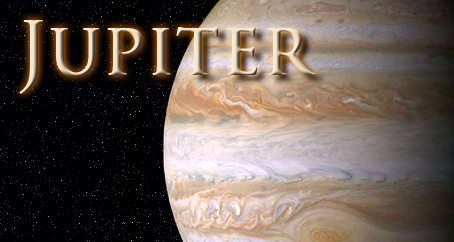Ten Facts about Jupiter
Fact One
Jupiter has a liquid metal ocean (metallic hydrogen) at its centre, surrounded by thousands of kilometres of hydrogen and helium gas.
Fact Two
Jupiter's famous Red Spot is in fact a storm the size of Earth that has raged for hundreds of years.
Fact Three
Jupiter has a thin set of rings, hardly visible, even with telescopes, from Earth.
Fact Four
Jupiter is the vacuum cleaner of the Solar System. It sucks in comets, asteroids and meteorites which could be on a collision course for Earth. The comet, Shoemaker-Levy 9, was pulled apart by Jupiter's gravity and eventually collided with the planet in 1994.
Fact Five
Jupiter takes only 9 hours and 55 minutes to spin on its axis. This means a day on Jupiter is less than 10 hours long. Its fast rotation causes the planet to be squashed, being wider at the equator than from North to South.
Fact Six
Jupiter is the planet with the strongest pull of gravity in the Solar System. If we were able to stand on the surface of Jupiter, we would weigh three times as much as we would weigh on Earth. The only other object in the Solar System with a stronger pull of gravity is the Sun.
Fact Seven
The mass of Jupiter is 318 greater than the mass of Earth.
Fact Eight
Jupiter's moon, Ganymede, is the biggest moon in the Solar System.
Fact Nine
If we were able to see Jupiter's radiation belt from Earth, Jupiter would appear as big as the Sun.
Fact Ten
Jupiter's gravity is used to catapult space-craft on deep space missions further away. This is how the Voyager missions of 1975 managed to succeed.

View facts about other destinations

Jupiter Statistics Table
| Name | Jupiter |
| Meaning of Name | Roman King of the gods and ruler of Olympus. Greek equivalent is Zeus, son of Cronos (Saturn) |
| Name in Foreign Languages | Jupiter (French, German, Latin), Júpiter (Spanish, Portuguese),
Giove (Italian), Yupiter (Russian), Zeus (Greek) |
| Average Distance from the Sun |
778,412,020 km / 483,682,810 miles / 5.203 A.U. Comparison with Earth: 149,597,890 km / 92,955,820 miles / 1.000 A.U. |
| Closest Distance to the Sun (Perihelion) | 740,742,600 km / 460,276,100 miles / 4.952 A.U. Comparison with Earth: 147,100,000 km / 91,400,000 miles / 0.983 A.U. |
| Farthest Distance from the Sun (Aphelion) |
816,081,400 km / 507,089,500 miles / 5.455 A.U. Comparison with Earth: 152,100,000 km / 94,500,000 miles / 1.017 A.U. |
| Diameter across equator | 142,984 km / 88,846 miles Comparison with Earth: 12,756 km / 7,926 miles |
| Diagram showing planet's size compared to the size of Earth |
 |
| Circumference around equator |
449,197 km / 279,118 miles Comparison with Earth: 40,074 km / 24,901 miles |
| Mass | 1,898,700,000,000,000,000,000,000,000 kg Comparison with Earth: 5,973,700,000,000,000,000,000,000 kg |
| Time to spin on Axis | 9 hours, 55 minutes Comparison with Earth: 23 hours, 56 minutes |
| Time to orbit the Sun | 11 years, 314 days Comparison with Earth: 365 days, 6 hours |
| Distance planet travels to complete one orbit | 4,774,000,000 km / 2,996,000,000 miles Comparison with Earth: 924,375,700 km / 574,380,400 miles |
| Gravity (Earth = 1) | 2.14 |
| Escape Velocity | 214,300 km/h / 133,200 mph Comparison with Earth: 40,248 km/h / 25,009 mph |
| Temperature at Cloud Tops | -148 °c / -234 °F / 125 K Comparison with Earth's average temp: 15 °c / 59 °F / 288 K |
| Maximum Surface Temperature | 462 °C / 864 °F / 735 K Comparison with Earth: 58 °c / 136 ° F / 331 K |
| Weather Conditions | Cold at the tops of the clouds, temperatures rise to 152 °c 600 km into them. Thunderstorms are present across the planet, although are not as common as on Earth. Wind speeds have been measured at 640 km/h, and a storm present in the planet's Red Spot has been observed for centuries. |
| Contents of Atmosphere | 88-92% hydrogen (H2), 8-12% helium (He). Other gases present in smaller quantities are 0.3% methane (me), 0.026% ammonia (NH3), 0.003% hydrogen deuteride (HD), 0.0006% ethane (C2H6), 0.0004% water (H2O). Ices present include ammonia (NH3), water (H2O) and ammonium hydrosulfide (NH4SH) |
| Known moons | There are 63 moons known to orbit Jupiter - Metis (1980), Adrastea (1979), Amalthea (1892), Thebe (1980), Io (1610), Europa (1610), Ganymede (1610, Callisto (1610), Themisto (1975/2000), Leda (1974), Lysithea (1938), Elara (1905), S/2000 J 11 (2001), Carpo (2003), S/2003 J 12 (2003), Euporie (2002), S/2003 J 3 (2003), S/2003 J 18 (2003), Thelxinoe (2004), Euanthe (2002), Helike (2003), Orthosie (2002), Iocaste (2001), S/2003 J 16 (2003), Praxidike (2001), Harpalyke (2001), Mneme (2003), Hermippe (2002), Thyone (2002), Ananke (1951), S/2003 J 17 (2003), Aitne (2002), Kale (2002), Taygete (2001), S/2003 J 19 (2003), Chaldene (2001), S/2003 J 15 (2003), S/2003 J 10 (2003), S/2003 J 23 (2004), Erinome (2001), Aoede (2003), Kallichore (2003), Kalyke (2001), Carme (1938), Callirrhoe (2000), Eurydome (2002), Pasithee (2002), Cyllene (2003), S/2003 J 4 (2003), Pasiphaë (1908), Hegemone (2003), Arche (2002), Isonoe (2001), S/2003 J 9 (2003), S/2003 J 5 (2003), Sinope (1914), Sponde (2002), Autonoe (2002), Kore (2003), Megaclite (2001), S/2003 J 2 (2003) |
| Past Missions (including nationality and year of launch) | Pioneer 10 (USA, 1972), Pioneer 11 (USA, 1972) |
| Present Missions | Voyager 1 (USA, 1977), Voyager 2 (USA, 1977), Galileo (USA, 1989), Ulysses (USA/Europe, 1990), Cassini-Huygens (USA/Europe/Italy, 1997), New Horizons (USA, 2006). Note that although these are still active missions, all apart from Ulysses have long since past by Jupiter and are at other locations in the Solar System. |
| Planned Missions | There are no missions currently planned to visit Jupiter |
